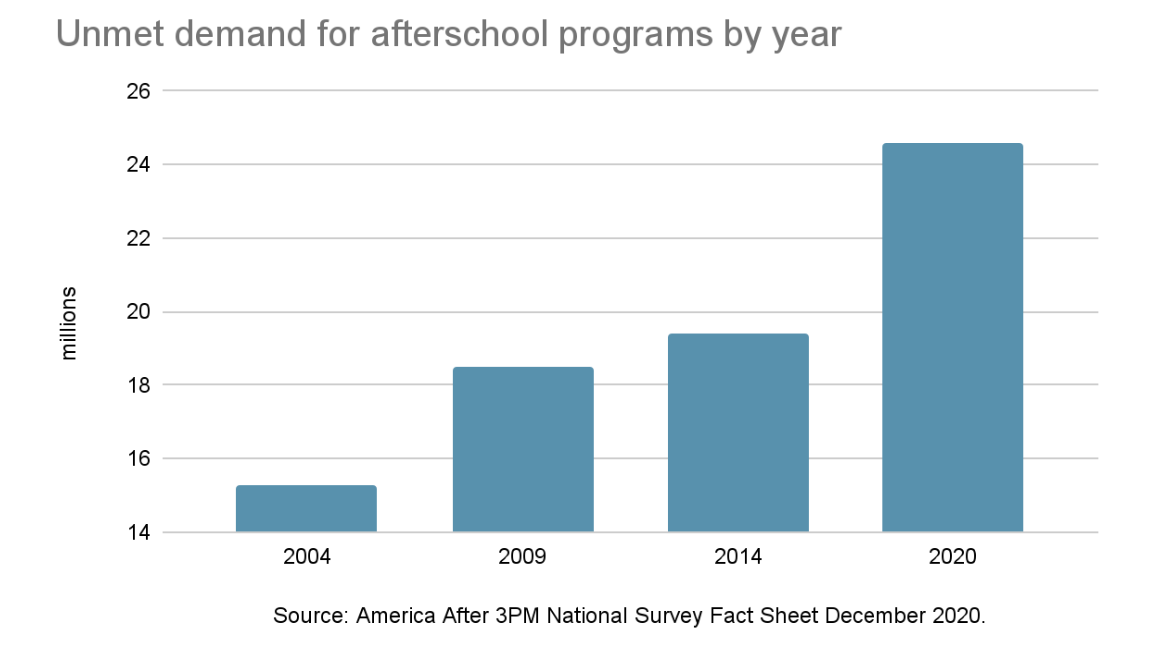Meeting The Demands of Out-of-School Time (OST) Programs
Meeting The Demands of Out-of-School Time (OST) Programs
The best time to start or expand your out-of-school time (OST) program is now! Before the COVID-19 pandemic began, many parents were eagerly awaiting their child’s turn for a spot in their local programs. Demand has increased even further since then. Research shows that for every child enrolled in an afterschool program, there are four waiting to get in.1 We want to inspire you to push forward with enthusiasm this year, to serve as many children as you can–they want what you have to offer!
88% of adults agree that school-age children should have opportunities outside of the school day to explore topics that interest them, try out new things, and gain skills like communication and teamwork.2
|
OST Programs in Demand for 2023 |
|
|
Program Type |
Why NOW? |
|
★ STEM(Science,Technology, Engineering, and Math) |
In a pre-pandemic Afterschool Alliance survey, almost 60 percent of parents reported that their children were receiving STEM instruction at least two days a week in an afterschool program.3 Setting the foundation for real-world success is beneficial to all children! |
|
★ Physical Fitness Activities |
As a result of increased time spent indoors and reduced access to nutritional meals, the COVID-19 pandemic has exacerbated the risk of weight gain among children.4 Promoting healthy minds and bodies is always a win–time to make it a priority! |
|
★ Multipurpose Programs |
Among students regularly attending a community learning center, approximately 1 in 2 improved their math and language arts grades, more than 2 out of 3 improved homework completion, and more than 3 out of 5 improved behavior in class.5 Think of what an impact you can make by offering comprehensive services! |
Unmet Demand and Barriers to Participation
According to a 2020 survey, 24.6 million kids would participate in an afterschool program if one were available to them.3
Demand for OST programs increased steadily in the years leading up to the pandemic, making pandemic closures and restrictions even harder on already-taxed communities.

The difficult circumstances created by the pandemic added additional strains on families, increasing barriers to OST participation. Parents report financial cost as the top barrier to participation in afterschool programs.1
The good news is, there are a plethora of resources available to help fund your program!
Strategies for Meeting the Demand
Applying for grants can be an arduous task, but thankfully grant applications provide comprehensive, step-by-step instructions to make the process as streamlined as possible. If you are new to applying for grants and lack the funds to hire an outside grant writer, there are many free resources available online and in your community–such as your local library–to help you with the process.
Funding
- COVID-19 relief funds: If you have not yet received any form of benefit via relief funds allocated to the Elementary and Secondary School Emergency Relief (ESSER) program, now is the time to check with your school district to see how these dollars are being spent. The third and final round of relief through this program is set to expire in the fall of 2024;6 it is possible that not all districts have spent the entirety of these funds yet. Make sure they know the invaluable work you are doing for your community!
-
Grants: Check out specific grants available to you in your state. Know that the amount of opportunities for funding is growing, so continue to check for new updates. Most public library systems contain a grants collection–or at least a knowledgeable librarian who can help you navigate the waters.
Staffing
- AmeriCorps volunteers: The AmeriCorps program is an incredible resource for both people power and funding! Check to see if you qualify for one of their many partnership opportunities.
- Family members: Encourage the involvement of grandparents, aunts, cousins, and other important figures in a child’s life. Most often, a simple background check is all that is required of volunteers. This approach is a great way to support family development and connection.
- Community members: College students, retired teachers, and youths seeking work experience are some of the most common groups of individuals seeking volunteer experience. Consider the best ways to connect with them in your community–perhaps by posting a flyer at the local coffee shop, posting in a community Facebook group, or reaching out to your local college via phone or email.
Curacubby is Here to Support Your Growth!
Visit our Website and Knowledge Base to learn more.
Check out our blog for more information you can use right away.
Get in touch with an Out-of-School Time Specialist for a customize approach to supporting your Before and Afterschool Programs
1 Source:Afterschool Alliance Parent Survey 2022. http://www.afterschoolalliance.org/AA3PM/
4 Source: https://www.ncbi.nlm.nih.gov/pmc/articles/PMC7440663/
6 Source: Education Week, January 19, 2023. https://www.edweek.org/leadership/covid-relief-funds-dry-up-next-year-heres-how-districts-can-cope/2023/01








